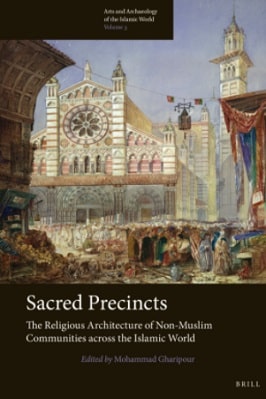
| Sacred Precincts |
| Mohammad Gharipour Nilay Ozlu |
| 580 |
| |
| PDF Direct Download Link |
| Click for Hard Copy from Amazon |
Sacred Precincts – The Religious Architecture of Non-Muslim Communities across the Islamic World Edited by Mohammad Gharipour
SACRED PRECINCTS – THE RELIGIOUS ARCHITECTURE OF NON-MUSLIM COMMUNITIES ACROSS THE ISLAMIC WORLD
Books preface
Non-Muslim Sacred Sites in the Muslim World
The extensive history of relations between Muslims and non-Muslims is a history of physical, metaphorical, and ideological proximities and distances.
Because of Islam’s originary historical and geographical contexts, these proximities and distances emerged perhaps most strikingly at the intersections of and in the interstices between the smoothing forces of Arab nomadism and the hierarchical striations of the sedentary monumentalism of the societies that have encountered, and in some cases converted to, Islam.1
From among the myriad expressions of Muslim and non-Muslim identities, sacred architecture provides unique insights into the complex interactions between Islam and other religious and spiritual traditions.
More than just temples, synagogues, churches, and mosques, sacred architecture comprises the visible and invisible sites, complexes, structures, and spaces (natural and built) where members of a community manifest their devotion and summon divine presence by performing the recitations, rituals, and processions that distinguish them as adherents to a particular set of beliefs.2
Relationships between sacred buildings convey relationships between people of different faiths. In the case of Islam, they also call attention to historical misconceptions about interreligious intolerance.
Cultural diffusions and collisions in predominantly Islamic countries have resulted in complex conceptual exchanges between Muslims and religious minorities.
The design and construction processes undertaken by various inhabitants of those communities often reflect the minorities’ relations with Muslims and the government as well as the competitive tensions and reconciliations within and between member groups.
The temples, churches, synagogues, and sacred sites and spaces that remain or emerged after the arrival of Islam and their relationship with the urban fabric reveal shifting notions of the sacred over time and the internal complexities of the Islamic world, and illustrate the articulation of cultural identity.
During times of heightened tensions, non-Muslims’ religious buildings became less visible in terms of height, location, and even ornamentation. In general, most non-Muslim religious buildings adopted the local language of architecture and local materials.
This also varied at times. European artists and architects found an opportunity to play a role in the construction of churches in the Islamic world in cities such as Istanbul and Isfahan.
Reliance on local resources had much to do with the constraints of finance but also created a sense of protection for people who might easily be accused of establishing relations with outside enemies.
Several issues have made it difficult for historians, theologians, and anthropologists to determine to what extent the ‘facts’ of sacred architecture (latitude and longitude of the sites, dimensions of the structures and spaces, materials used in construction, relationships between buildings within a complex and between buildings
To read more about the Sacred Precincts book Click the download button below to get it for free
or
Report broken link
Support this Website
for websites